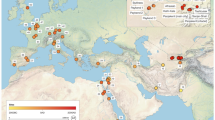Abstract
HELMINTH eggs vary widely in their structure and, consequently, in their ability to resist desiccation and destruction. But usually theirs is the most resistant stage in the life-cycle of the worm and any conclusions to be made, concerning early helminthic infections, are most likely to come from recognition of these eggs. These have been recovered from three sources: mummified or otherwise preserved bodies, formed stools and soil from cesspits or similar structures. While the first two sources can provide more positive identification of the origin of the eggs, it is from the third source that the greatest variety of species has been obtained, presumably because they accumulate over a period of time. Here is reported an investigation in which soil from a Roman Age occupation at Owlesbury, near Winchester, was examined in the hope that positive identification of eggs might provide some clue to the nature of the occupation, to supplement the archaeological evidence. I have reviewed the literature on similar investigations1.
This is a preview of subscription content, access via your institution
Access options
Subscribe to this journal
Receive 51 print issues and online access
$199.00 per year
only $3.90 per issue
Buy this article
- Purchase on Springer Link
- Instant access to full article PDF
Prices may be subject to local taxes which are calculated during checkout
Similar content being viewed by others
References
Pike, A. W., in Diseases in Antiquity (edit. by Brothwell, D. R. and Sandison, A. T.), 184 (Charles C. Thomas, Illinois, 1967).
Callen, E. O., and Cameron, T. W. M., New Scient., 8, 35 (1960).
Taylor, E. L., Vet. Rec., 67, 216 (1955).
Samuels, R., Mem. Soc. Amer. Archaeol., 19, 175 (1965).
Størmer, L., Skr. Norske Vidensk.-Akad. Mat-naturv. Kl., 8, 171 (1963).
Author information
Authors and Affiliations
Rights and permissions
About this article
Cite this article
PIKE, A. Recovery of Helminth Eggs from Archaeological Excavations, and their Possible Usefulness in providing Evidence for the Purpose of an Occupation. Nature 219, 303–304 (1968). https://doi.org/10.1038/219303a0
Published:
Issue Date:
DOI: https://doi.org/10.1038/219303a0
This article is cited by
Comments
By submitting a comment you agree to abide by our Terms and Community Guidelines. If you find something abusive or that does not comply with our terms or guidelines please flag it as inappropriate.



